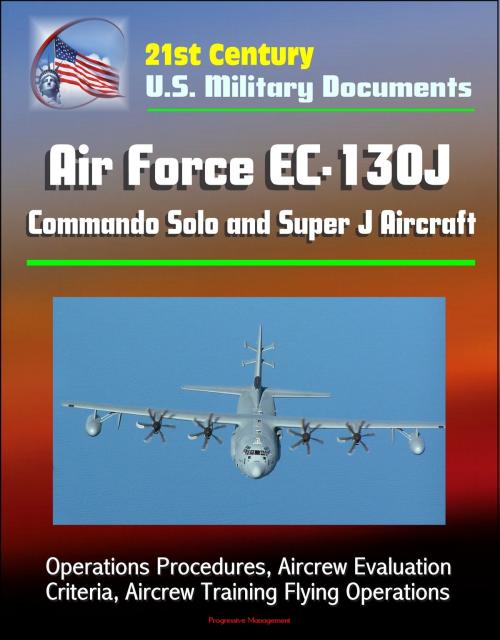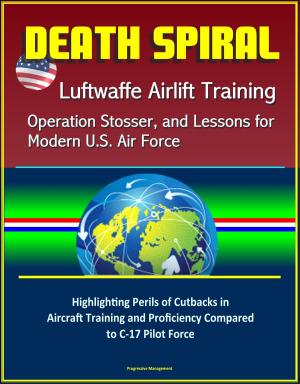21st Century U.S. Military Documents: Air Force EC-130J Commando Solo and Super J Aircraft - Operations Procedures, Aircrew Evaluation Criteria, Aircrew Training Flying Operations
Nonfiction, Science & Nature, Technology, Aeronautics & Astronautics, History, Military, Aviation| Author: | Progressive Management | ISBN: | 9781311963062 |
| Publisher: | Progressive Management | Publication: | November 8, 2013 |
| Imprint: | Smashwords Edition | Language: | English |
| Author: | Progressive Management |
| ISBN: | 9781311963062 |
| Publisher: | Progressive Management |
| Publication: | November 8, 2013 |
| Imprint: | Smashwords Edition |
| Language: | English |
Three Air Force documents provide unique information about USAF operations of the EC-130J Commando Solo and Super J aircraft.
Contents: Operations Procedures * Aircrew Evaluation Criteria * Aircrew Training
Chapter 1 * GENERAL INFORMATION * 1.1. General * 1.2. Applicability * 1.3. Supplements * 1.4. Requisitioning Procedures * 1.5. Distribution * 1.6. Deviations and Waivers * 1.7. Key Words * 1.8. Definitions * 1.9. Aircrew Operational Reports * Chapter 2 * COMMAND AND CONTROL * 2.1. General * 2.2. Reporting Requirements * 2.3. Reporting Procedures * 2.4. Mission Commander * 2.5. Designated Non Commissioned Officer In Charge (NCOIC) * 2.6. Mission Clearance Decision * 2.7. C2 Agency Telephone Numbers * 2.8. Operational C2 Reporting * 2.9. Posse Comitatus * Chapter 3 * CREW COMPLEMENT AND MANAGEMENT * 3.1. Aircrew Qualification * 3.2. Crew Complement * 3.3. Additional Crewmembers/Non-Interference Flyers/Mission Essential Ground Personnel * 3.4. Interfly * 3.5. Scheduling Restrictions * 3.7. CDT and FDP * Chapter 4 * AIRCRAFT OPERATING RESTRICTIONS * 4.1. Objective * 4.2. Minimum Equipment List (MEL) Policy * 4.3. Waiver Protocol * 4.4. Technical Assistance Service * 4.5. One-Time Flights * 4.6. Fuel System * 4.7. Navigation Systems * 4.8. Soft Panel Operations * 4.9. Authority to Clear a Red X * 4.10. Maintenance Identifiers * 4.11. MEL Table Definitions/Column Identifiers * 4.12. Special Mission Equipment (SME) Failures * Chapter 5 * AIRLAND/MISSION PARAMETERS * 5.1. Aircraft Maximum Gross Weight Policy * 5.2. Checklists * 5.3. Duty Station * 5.4. Flight Station Entry * 5.5. Flight Deck Congestion and Loose Objects * 5.6. Takeoff and Landing Policy * 5.7. Use of Outside Observer * 5.8. Seat Belts * 5.9. Crew Bunks * 5.10. Aircraft Lighting * 5.11. Advisory Calls * 5.12. Communications Policy * 5.13. Wind Limitations * 5.14. Maximum Effort Procedures * 5.15. Substandard Airfield Operations * 5.16. Runway, Taxiway and Airfield Requirements * 5.17. Aircraft Taxi Procedures and Taxi Obstruction Clearance Criteria * 5.18. Foreign Object Damage (FOD) Avoidance * 5.19. Reverse Taxi * 5.20. Arresting Cables * 5.21. Takeoff and Landing Obstruction Criteria * 5.22. Landing Gear and Flap Operating Policy * 5.23. Intersection Takeoffs * 5.24. Tactical Flight Operations * 5.25. Fuel Planning * 5.26. CS Trailing Wire Antenna (TWA) Operations * 5.27. Threat Maneuvers * 5.28. Controlled Cockpit Rest * 5.29. Arrival * 5.30. Traffic Pattern * 5.31. Random Approaches * 5.32. ERCC/ERO * Chapter 6 * GENERAL OPERATING PARAMETERS * 6.1. Aircrew Uniform * 6.2. Personal Requirements and Professional Equipment * 6.3. Aircraft Tool Kits * 6.4. Aircrew Publications Requirements * 6.5. Aircraft Mission Kits * 6.6. Flight Crew Information File (FCIF) * 6.7. AC Briefing * 6.8. Call Signs * 6.9. Flight Data Verification * 6.10. Departure Planning * 6.11. Obstacle Clearance Planning * 6.12. Alternate Planning * 6.13. Weather Minimums * 6.14. Departure Alternates * 6.15. Destination Requirements * 6.16. Adverse Weather * 6.17. TCAS * 6.18. Radar Altimeter * 6.19. GCAS * 6.20. Fuel Jettison Procedures * 6.21. Portable Electronic Devices * 6.22. Hand-Held GPS * 6.23. Bird Aircraft Strike Hazard (BASH) Programs * 6.24. Functional Check Flights (FCFs) and Acceptance Check Flights * 6.25. Operational Check Flights (OCFs) * 6.26. Participation in Aerial Events * 6.27. Tobacco Products * 6.28. Route Navigation Kits * 6.29. Authenticators and Classified Documents * 6.30. Alcoholic Beverages * 6.31. AFTO Form 781, ARMS Aircrew/Mission Flight Data Document * 6.32. Aircraft Servicing and Ground Operations * 6.33. Aircrew Dash One Preflight * 6.34. Aircrew Flight Equipment (AFE) Documentation * 6.35. Aircrew Flight Equipment Requirements * 6.36. Fleet Service * 6.37. Cargo Documentation * 6.38. Procedures for Airlifting Hazardous Cargo * 6.39. Handling of Classified Cargo, Registered Mail * 6.40. Passenger Policy * 6.41. Narcotics
Three Air Force documents provide unique information about USAF operations of the EC-130J Commando Solo and Super J aircraft.
Contents: Operations Procedures * Aircrew Evaluation Criteria * Aircrew Training
Chapter 1 * GENERAL INFORMATION * 1.1. General * 1.2. Applicability * 1.3. Supplements * 1.4. Requisitioning Procedures * 1.5. Distribution * 1.6. Deviations and Waivers * 1.7. Key Words * 1.8. Definitions * 1.9. Aircrew Operational Reports * Chapter 2 * COMMAND AND CONTROL * 2.1. General * 2.2. Reporting Requirements * 2.3. Reporting Procedures * 2.4. Mission Commander * 2.5. Designated Non Commissioned Officer In Charge (NCOIC) * 2.6. Mission Clearance Decision * 2.7. C2 Agency Telephone Numbers * 2.8. Operational C2 Reporting * 2.9. Posse Comitatus * Chapter 3 * CREW COMPLEMENT AND MANAGEMENT * 3.1. Aircrew Qualification * 3.2. Crew Complement * 3.3. Additional Crewmembers/Non-Interference Flyers/Mission Essential Ground Personnel * 3.4. Interfly * 3.5. Scheduling Restrictions * 3.7. CDT and FDP * Chapter 4 * AIRCRAFT OPERATING RESTRICTIONS * 4.1. Objective * 4.2. Minimum Equipment List (MEL) Policy * 4.3. Waiver Protocol * 4.4. Technical Assistance Service * 4.5. One-Time Flights * 4.6. Fuel System * 4.7. Navigation Systems * 4.8. Soft Panel Operations * 4.9. Authority to Clear a Red X * 4.10. Maintenance Identifiers * 4.11. MEL Table Definitions/Column Identifiers * 4.12. Special Mission Equipment (SME) Failures * Chapter 5 * AIRLAND/MISSION PARAMETERS * 5.1. Aircraft Maximum Gross Weight Policy * 5.2. Checklists * 5.3. Duty Station * 5.4. Flight Station Entry * 5.5. Flight Deck Congestion and Loose Objects * 5.6. Takeoff and Landing Policy * 5.7. Use of Outside Observer * 5.8. Seat Belts * 5.9. Crew Bunks * 5.10. Aircraft Lighting * 5.11. Advisory Calls * 5.12. Communications Policy * 5.13. Wind Limitations * 5.14. Maximum Effort Procedures * 5.15. Substandard Airfield Operations * 5.16. Runway, Taxiway and Airfield Requirements * 5.17. Aircraft Taxi Procedures and Taxi Obstruction Clearance Criteria * 5.18. Foreign Object Damage (FOD) Avoidance * 5.19. Reverse Taxi * 5.20. Arresting Cables * 5.21. Takeoff and Landing Obstruction Criteria * 5.22. Landing Gear and Flap Operating Policy * 5.23. Intersection Takeoffs * 5.24. Tactical Flight Operations * 5.25. Fuel Planning * 5.26. CS Trailing Wire Antenna (TWA) Operations * 5.27. Threat Maneuvers * 5.28. Controlled Cockpit Rest * 5.29. Arrival * 5.30. Traffic Pattern * 5.31. Random Approaches * 5.32. ERCC/ERO * Chapter 6 * GENERAL OPERATING PARAMETERS * 6.1. Aircrew Uniform * 6.2. Personal Requirements and Professional Equipment * 6.3. Aircraft Tool Kits * 6.4. Aircrew Publications Requirements * 6.5. Aircraft Mission Kits * 6.6. Flight Crew Information File (FCIF) * 6.7. AC Briefing * 6.8. Call Signs * 6.9. Flight Data Verification * 6.10. Departure Planning * 6.11. Obstacle Clearance Planning * 6.12. Alternate Planning * 6.13. Weather Minimums * 6.14. Departure Alternates * 6.15. Destination Requirements * 6.16. Adverse Weather * 6.17. TCAS * 6.18. Radar Altimeter * 6.19. GCAS * 6.20. Fuel Jettison Procedures * 6.21. Portable Electronic Devices * 6.22. Hand-Held GPS * 6.23. Bird Aircraft Strike Hazard (BASH) Programs * 6.24. Functional Check Flights (FCFs) and Acceptance Check Flights * 6.25. Operational Check Flights (OCFs) * 6.26. Participation in Aerial Events * 6.27. Tobacco Products * 6.28. Route Navigation Kits * 6.29. Authenticators and Classified Documents * 6.30. Alcoholic Beverages * 6.31. AFTO Form 781, ARMS Aircrew/Mission Flight Data Document * 6.32. Aircraft Servicing and Ground Operations * 6.33. Aircrew Dash One Preflight * 6.34. Aircrew Flight Equipment (AFE) Documentation * 6.35. Aircrew Flight Equipment Requirements * 6.36. Fleet Service * 6.37. Cargo Documentation * 6.38. Procedures for Airlifting Hazardous Cargo * 6.39. Handling of Classified Cargo, Registered Mail * 6.40. Passenger Policy * 6.41. Narcotics















